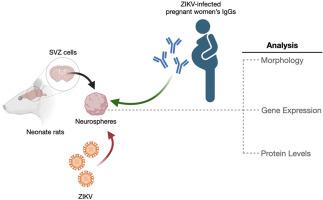Influence of IgG+ serum on Zika virus infection response in a model of neural precursor cells
IF 2.2
Q3 BIOCHEMISTRY & MOLECULAR BIOLOGY
引用次数: 0
Abstract
The high frequency of Zika virus (ZIKV) infection prompted the World Health Organization (WHO) to declare it an emerging threat in 2016. Presently, countries in South America continue to report a significant number of Zika virus cases. Zika virus infection has been associated with neurological diseases. This article explores the impact of ZIKV infection on IgG + Zika-reactive conditions using a neurosphere model. For this investigation, neurospheres derived from Wistar rats were exposed to the Zika virus and to IgG + conditions reactive to Zika. The relative expression levels of the NOTCH-1, HES-1, and HEY-1 genes were assessed through quantitative Polymerase Chain Reaction (qPCR). Additionally, the concentrations of GCSF and IL-10 proteins were quantified using a Luminex immunoassay. Morphological evaluation of the neurospheres was conducted, with parameters such as area and irregularity rate being analyzed using Image Pro Plus 7 software.The irregularity rate of ZIKV neurospheres decreased at its lowest concentration; however, our morphology analysis was insufficient to fully elucidate the impact of ZIKV on neurospheres. Interestingly, IgG + serum exhibited neuroprotective effects against subsequent Zika virus exposure, restoring NOTCH-1 and HES-1 expression levels to normal. HEY-1 expression remained unaffected by Zika virus exposure but decreased with IgG + serum. Surprisingly, levels of the anti-inflammatory markers GCSF and IL-10 showed no significant changes. These findings highlight the complex interplay between ZIKV infection, immune response, and neurodevelopmental processes. Further research is necessary to elucidate the precise mechanisms underlying these observations and explore potential therapeutic interventions.

IgG+血清对神经前体细胞模型寨卡病毒感染反应的影响
寨卡病毒(ZIKV)的高频率感染促使世界卫生组织(WHO)在2016年宣布其为一种新兴威胁。目前,南美洲国家继续报告大量寨卡病毒病例。寨卡病毒感染与神经系统疾病有关。本文利用神经球模型探讨了寨卡病毒感染对IgG +寨卡反应性疾病的影响。在这项研究中,来自Wistar大鼠的神经球暴露于寨卡病毒和对寨卡病毒有反应的IgG +条件下。采用定量pcr法检测NOTCH-1、HES-1和HEY-1基因的相对表达量。此外,使用Luminex免疫分析法定量GCSF和IL-10蛋白的浓度。对神经球进行形态学评价,利用Image Pro Plus 7软件分析面积、不规则率等参数。寨卡病毒神经球不规则率在寨卡病毒浓度最低时降低;然而,我们的形态学分析不足以充分阐明寨卡病毒对神经球的影响。有趣的是,IgG +血清对随后的寨卡病毒暴露表现出神经保护作用,使NOTCH-1和HES-1表达水平恢复正常。HEY-1的表达不受寨卡病毒的影响,但IgG +血清的表达降低。令人惊讶的是,抗炎标志物GCSF和IL-10的水平没有明显变化。这些发现强调了寨卡病毒感染、免疫反应和神经发育过程之间复杂的相互作用。需要进一步的研究来阐明这些观察结果背后的确切机制并探索潜在的治疗干预措施。
本文章由计算机程序翻译,如有差异,请以英文原文为准。
求助全文
约1分钟内获得全文
求助全文
来源期刊

Biochemistry and Biophysics Reports
Biochemistry, Genetics and Molecular Biology-Biophysics
CiteScore
4.60
自引率
0.00%
发文量
191
审稿时长
59 days
期刊介绍:
Open access, online only, peer-reviewed international journal in the Life Sciences, established in 2014 Biochemistry and Biophysics Reports (BB Reports) publishes original research in all aspects of Biochemistry, Biophysics and related areas like Molecular and Cell Biology. BB Reports welcomes solid though more preliminary, descriptive and small scale results if they have the potential to stimulate and/or contribute to future research, leading to new insights or hypothesis. Primary criteria for acceptance is that the work is original, scientifically and technically sound and provides valuable knowledge to life sciences research. We strongly believe all results deserve to be published and documented for the advancement of science. BB Reports specifically appreciates receiving reports on: Negative results, Replication studies, Reanalysis of previous datasets.
 求助内容:
求助内容: 应助结果提醒方式:
应助结果提醒方式:


